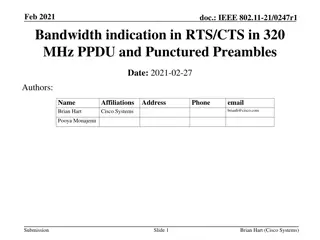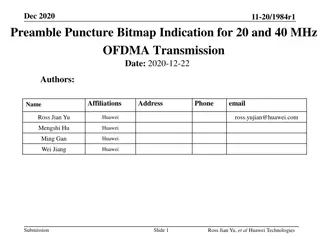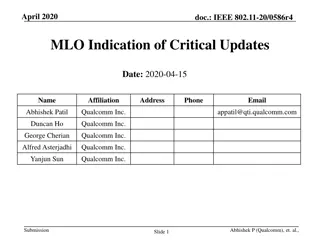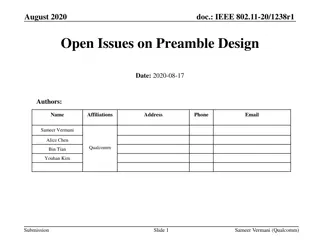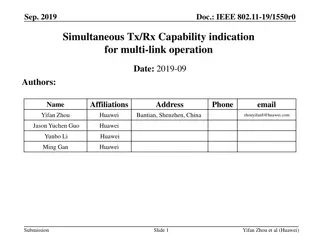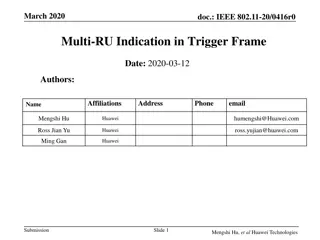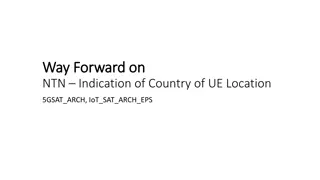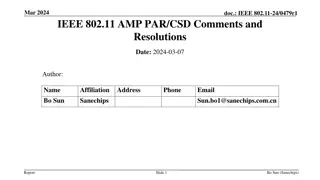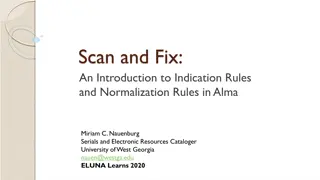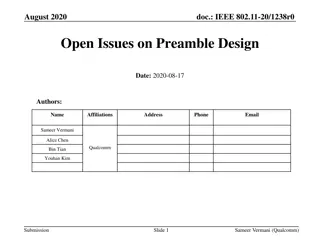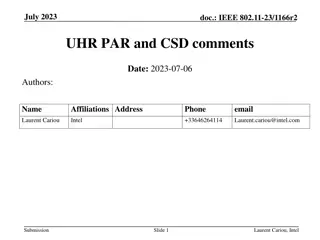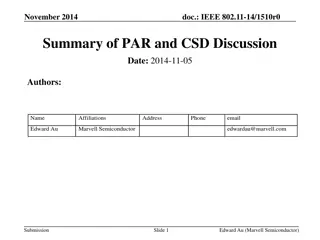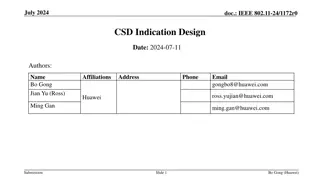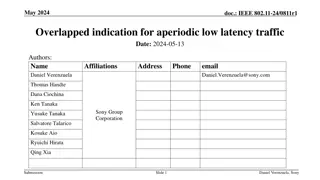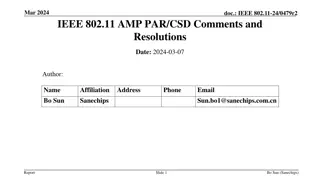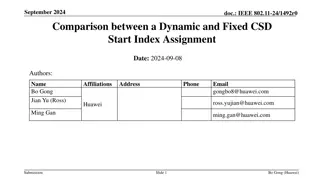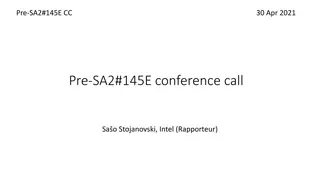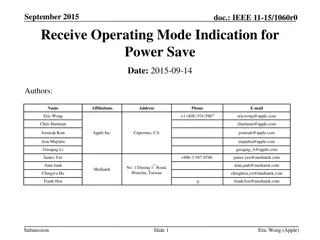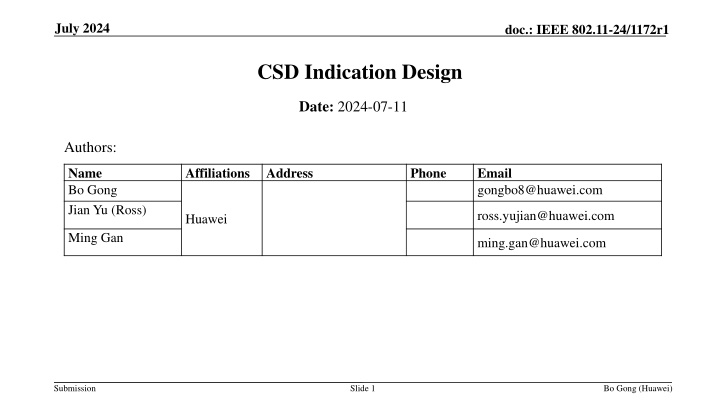
IEEE 802.11-24/1172r1 CSD Design Proposal for Improved Wireless Communication
Explore the advantages of allocating CSDs by AP in IEEE 802.11-24/1172r1 for enhanced AGC performance. This proposal suggests allocating CSDs per user by the AP, improving collision avoidance and optimized CSD allocation. Simulation results show reduced power gap ranges with and without collision, highlighting the benefits of this approach in a wireless communication setup.
Download Presentation

Please find below an Image/Link to download the presentation.
The content on the website is provided AS IS for your information and personal use only. It may not be sold, licensed, or shared on other websites without obtaining consent from the author. If you encounter any issues during the download, it is possible that the publisher has removed the file from their server.
You are allowed to download the files provided on this website for personal or commercial use, subject to the condition that they are used lawfully. All files are the property of their respective owners.
The content on the website is provided AS IS for your information and personal use only. It may not be sold, licensed, or shared on other websites without obtaining consent from the author.
E N D
Presentation Transcript
July 2024 doc.: IEEE 802.11-24/1172r1 CSD Indication Design Date: 2024-07-11 Authors: Name Bo Gong Jian Yu (Ross) Affiliations Address Phone Email gongbo8@huawei.com ross.yujian@huawei.com Huawei Ming Gan ming.gan@huawei.com Submission Slide 1 Bo Gong (Huawei)
July 2024 doc.: IEEE 802.11-24/1172r1 Background In [1], several motions related to STF transmission for DRU have been passed. They illustrate global CSD is applied in each distribution bandwidth to prevent unintentional beamforming. In [2], it is suggested that global CSD provides CSD start index i for each DRU. If Nss for this DRU is larger than 1, then it will use CSD[mod(i: i+Nss-1, 8)] for each spatial stream. In this proposal, we suggest that CSDs for each user are allocated by AP and the CSD start index for each user is indicated in the User Info field of the trigger frame. Submission Slide 2 Bo Gong (Huawei)
July 2024 doc.: IEEE 802.11-24/1172r1 Advantages of Allocating CSDs by AP There exists two direct ideas about CSD allocation. The one is fixing a CSD start index to a RU index. The other one is allocating CSDs by AP and indicating the start CSD index in User Info field of the trigger frame. Since DRU selection is up to scheduling algorithms and affected by many factors, such as transmission range, pilot channel and so on, any DRUs combination is possible to be triggered. Based on such consideration, it can be expected that allocating CSDs by AP achieves better AGC performance. The reason is that allocating CSDs by AP guarantees minimum collision and optimized CSD allocation. Here we assume AP allocates CSDs as the current CSD allocation corresponding to Nss. Minimum collision It can be verified that if the same CSD is allocated to two users, referred to as collision, the power gap between STF and Data will increase obviously. Optimized CSD allocation It can be verified that different CSD allocations correspond to different power gap between STF and Data. Taking Nss = 2 as an example, CSD values of [0, -400ns] brings smaller power gap between STF and Data than [-600ns, -650ns]. Submission Slide 3 Bo Gong (Huawei)
July 2024 doc.: IEEE 802.11-24/1172r1 Simulation Results: Part I In part I, we compare the performance for CSD Allocation with and without collision. 80MHz, 52-tone DRU, 2 users with 1ss per user, Channel D, SNR=30dB 80MHz, 52-tone DRU, 3 users with 1ss per user, Channel D, SNR=30dB 1 1 0.9 0.9 Note that 3 users with 1ss per user is just an example. 2 user with 2ss for one user and 1ss for the other user will present similar results. 0.8 0.8 [ 0 -400 -400] [ 0 -400 -200] [-400, -400] [0 -400] 0.7 0.7 0.6 0.6 CDF CDF 0.5 0.5 0.4 0.4 0.3 0.3 0.2 0.2 0.1 0.1 0 0 -4 -3 -2 -1 0 1 2 3 -4 -3 -2 -1 0 1 2 3 Power Ratio of STF/Data (dB) Power Ratio of STF/Data (dB) Observation: Observation: For 2 users with CSD collision, the power gap range is [-3.5, 2]dB; For 3 users with CSD collision, the power gap range is [-2.1, 1.6]dB; For 2 users without CSD collision, the power gap range is [-0.2, 0.4]dB; For 3 users without CSD collision, the power gap range is [-0.4, 0.3]dB; For 2 users if CSD collision is avoided, the power gap range is reduced by 5dB. For 3 users, if CSD collision is avoided, the power gap range is reduced by 3dB. Submission Slide 4 Bo Gong (Huawei)
July 2024 doc.: IEEE 802.11-24/1172r1 Simulation Results: Part I 80MHz, 52-tone DRU, 4 users with 1ss per user, Channel D, SNR=30dB 1 0.9 [ 0 -400 -400 -600 ] [ 0 -400 -200 -600 ] Note that 4 users with 1ss per user is just an example. 2 user with 2ss for each user will present similar results. 0.8 0.7 0.6 CDF 0.5 0.4 0.3 0.2 0.1 0 -4 -3 -2 -1 0 1 2 3 Power Ratio of STF/Data (dB) Observation: For 4 users with CSD collision, the power gap range is [-1.6, 1.4]dB; For 4 users without CSD collision, the power gap range is [-0.6, 0.4]dB; For 4 users, if CSD collision is avoided, the power gap range is reduced by 2dB. Submission Slide 5 Bo Gong (Huawei)
July 2024 doc.: IEEE 802.11-24/1172r1 Simulation Results: Part II In part II, we compare the performance for non-optimized and optimized CSD allocation. 1 [-600 -650] [0 -400] 80MHz, 52-tone DRU, 2 users with 1ss per user, Channel D, SNR=30dB 0.9 0.8 Observation: 0.7 0.6 For 2 users with non-optimized CSD allocation [-600, -650]ns , the power gap range is [-2.5, 1.5]dB; CDF 0.5 0.4 For 2 users with optimized CSD allocation [0 -400]ns, the power gap range is [-0.2, 0.4]dB; 0.3 0.2 For 2 users with optimized CSD allocation, the power gap range is reduced by 3.4dB. 0.1 0 -3 -2 -1 0 1 2 3 Power Ratio of STF/Data (dB) Submission Slide 6 Bo Gong (Huawei)
July 2024 doc.: IEEE 802.11-24/1172r1 Simulation Results: Part II 1 80MHz, 52-tone DRU, 3 users with 1ss per user, Channel D, SNR=30dB 0.9 Observation: [ 0 -400 -200] [ -600 -350 -650] [-600 -650 -750] 0.8 For 3 users with non-optimized CSD allocation [-600, -350, -650]ns , the power gap range is [-1.7, 1.2]dB; 0.7 0.6 CDF 0.5 For 3 users with non-optimal CSD allocation [-600, -650, -750]ns , the power gap range is [-1.8, 1.3]dB; 0.4 0.3 For 3 users with optimized CSD allocation [0 -400 -200]ns, the power gap range is [-0.4, 0.3]dB; 0.2 0.1 For 3 users with optimal CSD allocation, the power gap range is reduced by 2.3dB. 0 -3 -2 -1 0 1 2 3 Power Ratio of STF/Data (dB) Submission Slide 7 Bo Gong (Huawei)
July 2024 doc.: IEEE 802.11-24/1172r1 Simulation Results: Part II 1 80MHz, 52-tone DRU, 4 users with 1ss per user, Channel D, SNR=30dB 0.9 Observation: [ 0 -400 -200 -600 ] [ -600, -350, -650, -100] [ -600 -650 -350 -400] 0.8 For 4 users with non-optimized CSD allocation [-600, -350, -650, -100]ns , the power gap range is [-1.3, 0.9]dB; 0.7 0.6 For 4 users with non-optimized CSD allocation [-600, -650, -400, -350]ns , the power gap range is [-1.7, 1.1]dB; CDF 0.5 0.4 For 4 users with optimized CSD allocation [0 -400 -200 -600]ns, the power gap range is [-0.6, 0.4]dB; 0.3 0.2 For 3 users with optimized CSD allocation, the power gap range is reduced by 1.2~1.8dB. 0.1 0 -2 -1.5 -1 -0.5 Power Ratio of STF/Data (dB) 0 0.5 1 1.5 2 Submission Slide 8 Bo Gong (Huawei)
July 2024 doc.: IEEE 802.11-24/1172r1 Comparison In comparison to fixing a start CSD index to a DRU, allocating CSDs by AP has the following advantages. Provides obvious power measurement accuracy gain by minimizing the collision and optimizing the CSD allocation, especially when the number of users is small, which is the main scenario in practical systems. Reuses the implementation of CSD indication of UL-MU-MIMO. Submission Slide 9 Bo Gong (Huawei)
July 2024 doc.: IEEE 802.11-24/1172r1 Summary In this proposal, we suggest that CSDs for each user are allocated by AP and indicated in the User Info field of the trigger frame. In addition, we verify that CSDs allocated by AP achieves better AGC performance. Submission Slide 10 Bo Gong (Huawei)
July 2024 doc.: IEEE 802.11-24/1172r1 SP 1 Do you agree to add the following text to the TGbn SFD? In DRU transmission, the CSD start index for each user is indicated in the user info field. Submission Slide 11 Bo Gong (Huawei)
July 2024 doc.: IEEE 802.11-24/1172r1 References [1] 11-24-0209-02-00bn-specification-framework-for-tgbn [2] 11-24-0752-02-00bn-stf-design-consideration-for-dru Submission Slide 12 Bo Gong (Huawei)

